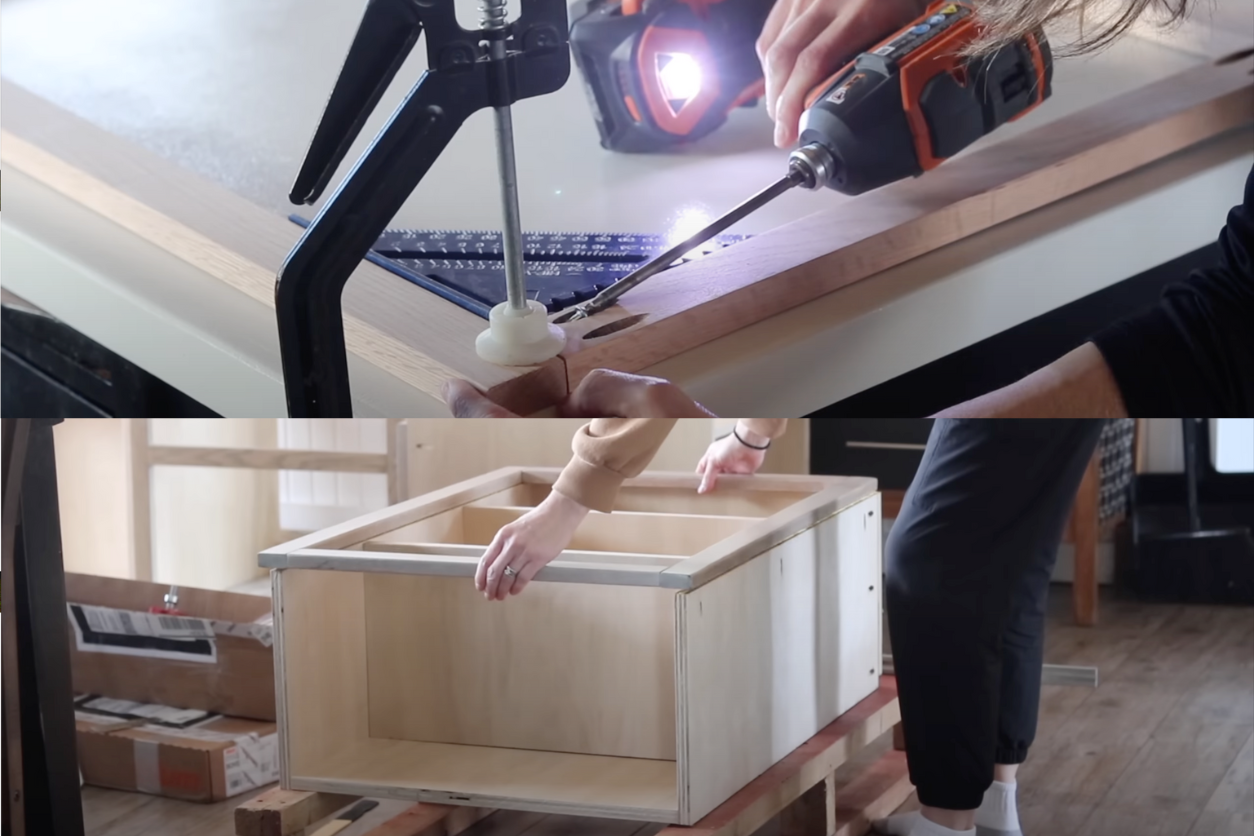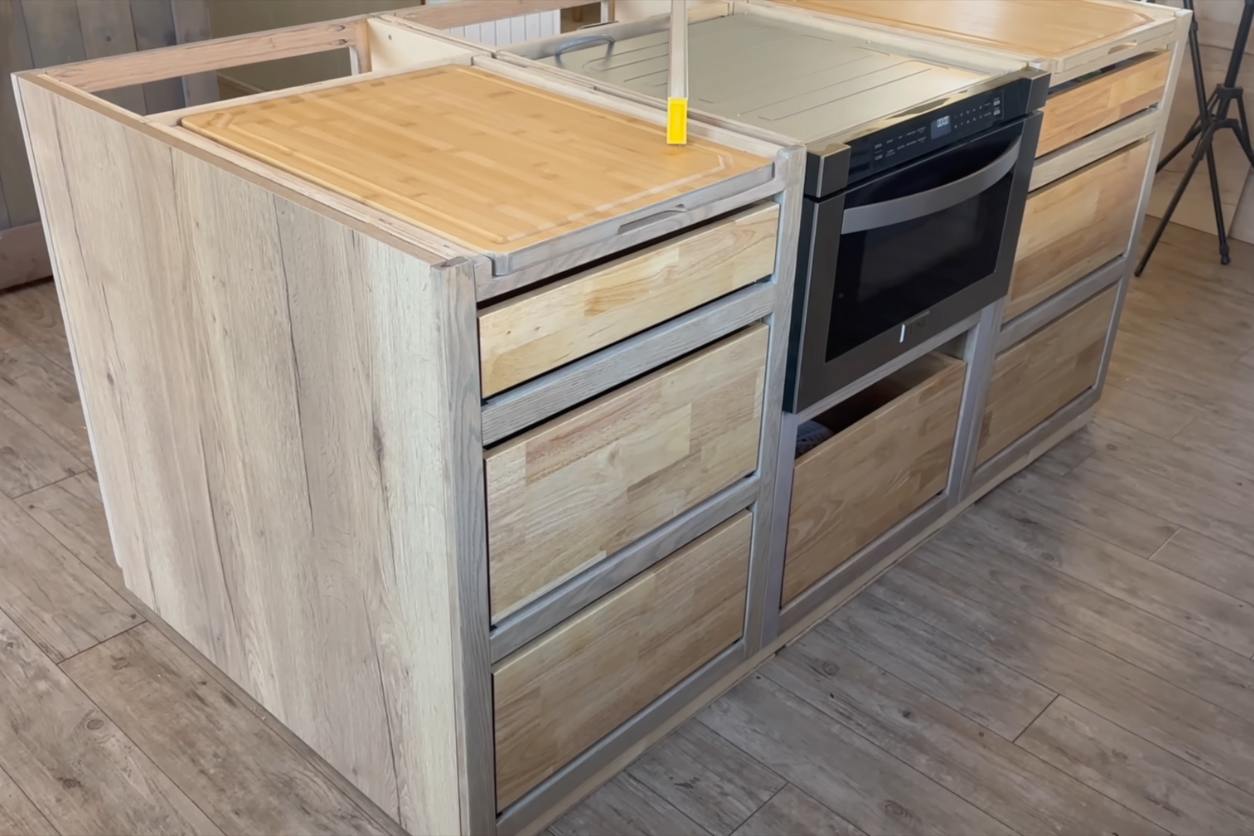How to DIY a Small Kitchen Island That Does Everything (Except Cleaning Dirty Dishes)

Image credit: Welcome to the Woods
Creating your own small kitchen island can seem like a big task, but it’s actually an exciting project that can transform your cooking space into a functional hub. Imagine having extra counter space for meal prep, storage for your pots and pans, a place for casual dining, and a spot for a Pinterest-worthy coffee bar — all in one spot. Of course, DIY projects come with their own set of challenges and learning curves, but that’s part of the fun. Plus, there’s nothing quite like the satisfaction of standing back and admiring something you built with your own hands.
Materials
- 3/4-inch thick plywood or hardwood boards for the sides and bottom
- Butcher block, granite, or laminate (size based on your island’s top dimensions)
- 8-foot length 2×4 Lumber (4-6 pieces)
- Full-extension drawer slides
- Cabinet handles or knobs
- Wood Glue and Screws: 1 1/4-inch and 2 1/2-inch wood screws
- Hinges (if adding doors)
- Sandpaper
- Wood stain, paint, or sealant
- Four heavy-duty casters if you want the island to be mobile
- Shelf Pins and Pegs (for adjustable shelves)
- Electrical Outlet Kit (optional)
Related: 10 Ways to Style a Kitchen Island With Table Extension
Tools
- Circular Saw or Table Saw
- Drill and Drill Bits
- Screwdrivers
- Measuring Tape
- Level
- Clamps
- Sander or Sanding Block
- Paintbrushes or Rollers
- Square
Estimated Cost
- Plywood/hardwood: $50 – $100 (depending on wood type and quality)
- Countertop material: $100 – $300 (varies greatly with material choice)
- Lumber: $20 – $50
- Drawer slides and hardware: $20 – $50
- Wood glue and screws: $10 – $20
- Hinges: $10 – $20
- Sandpaper and wood finish: $20 – $40
- Casters (optional): $20 – $40
- Electrical outlet kit (optional): $15 – $30
Total Estimated Cost: $245 – $650
|
Planning and Designing Your Small Kitchen Island

Before you dive into the actual building process, it’s crucial to spend some time on planning and design. Start by assessing your kitchen space to determine the best size and shape for your small kitchen island. Consider how you’ll use it—do you need more storage, additional prep space, or a spot for quick meals? This will help guide your design choices and ensure that your island meets your needs.
Once you have a rough idea, sketch out your design. It doesn’t have to be perfect, just enough to give you a visual guide. Think about the materials you’ll use, from the type of wood to the finish that’ll complement your existing kitchen décor. Consider incorporating elements like shelving, drawers, or even a built-in wine rack if that’s something you’d find useful.
Keep in mind the standard dimensions for kitchen islands, especially if you’re including seating. The typical height is about 36 inches, which matches most countertop heights, but you can adjust this depending on your personal preference and needs.
Building the Frame

With your materials ready, it’s time to start building the frame of your small kitchen island. Begin by cutting your wood to size, following your design plans. Remember to measure twice and cut once to avoid any costly mistakes. Assemble the frame using screws and wood glue for extra stability.
Related: 4 Ikea Kitchen Hacks Under $30
When constructing the frame, ensure everything is level and square. This is where your level becomes your best friend. A wobbly small kitchen island won’t be much use, so take the time to get this part right. If you’re planning on adding wheels for mobility, now’s the time to attach them to the base.
Next, add any shelves or dividers to the frame. These will provide structure and storage, so think about how you’ll be using your island and place them accordingly. If you’re including a section for a microwave or other appliances, make sure to account for the necessary space and ventilation.

Adding Finishing Touches
Once the frame is complete, it’s time to add the finishing touches that will really make your island shine. Sand down any rough edges and surfaces to create a smooth finish, then apply your chosen stain or paint. This is your chance to get creative and make the island your own, whether that means a bold color or a subtle wood stain that lets the natural grain shine through.
Install any drawers, doors, or other features you’ve included in your design. Make sure everything opens and closes smoothly, and make any adjustments needed to get things just right. If you’re adding a countertop, now’s the time to secure it to the frame. You can choose from a variety of materials like butcher block, granite, or even stainless steel, depending on your style and budget.

Finally, step back and admire your handiwork. You’ve created a unique and functional small kitchen island; now it’s time to put it to use. Invite friends over for dinner, prep a batch of cookies with the kids, or enjoy a morning coffee while sitting at your new island.
Our Recipe for Trust: Why Choose Kitchen Institute
At the Kitchen Institute, we're dedicated to providing reliable and accurate information on cooking trends, tips, and product reviews. Our team of passionate food enthusiasts ensures that every piece of content is thoroughly researched and based on real-world experience. We pride ourselves on our comprehensive and unbiased product reviews, rigorous research processes, and commitment to staying current with the latest culinary innovations. Trust us to enhance your culinary journey with quality insights and practical advice.